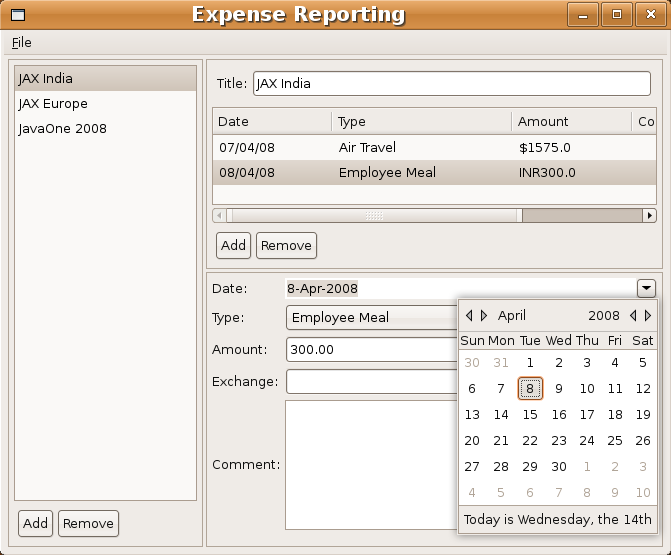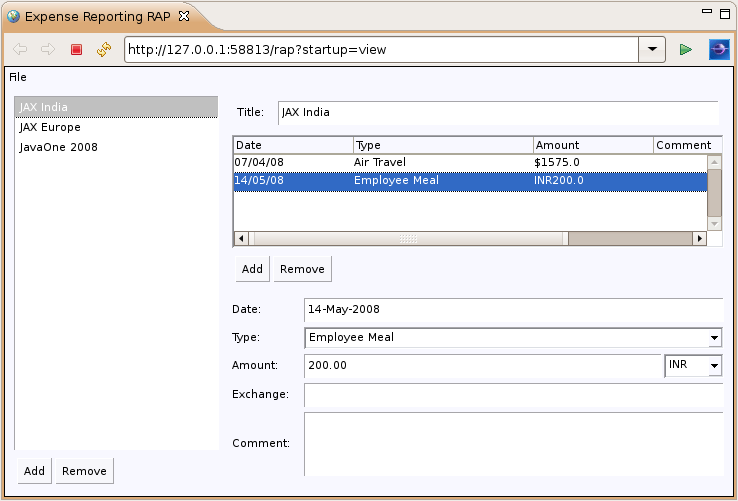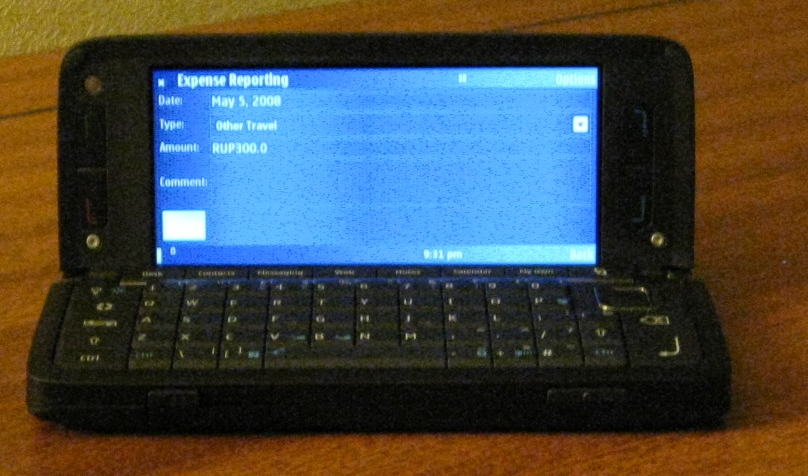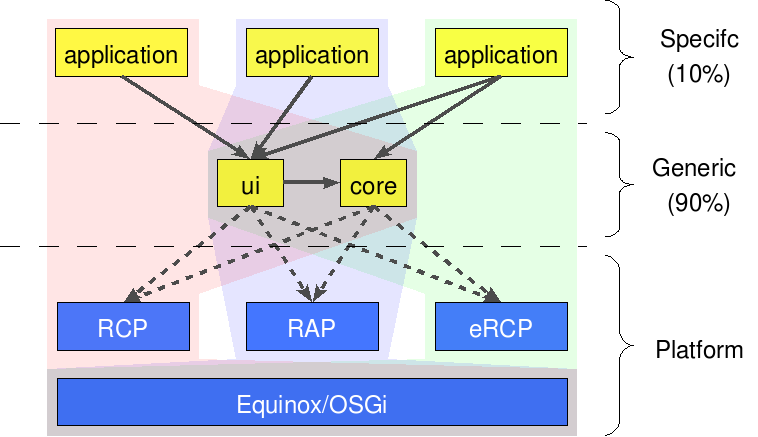Notice: this Wiki will be going read only early in 2024 and edits will no longer be possible. Please see: https://gitlab.eclipse.org/eclipsefdn/helpdesk/-/wikis/Wiki-shutdown-plan for the plan.
Difference between revisions of "Examples/Eclipse Business Expense Reporting Tool"
| Line 3: | Line 3: | ||
EBERT is a simple expense reporting tool that runs on the client, server, and embedded devices using [http://www.eclipse.org/rcp Eclipse Rich Client Platform] (RCP), [http://www.eclipse.org/rap Eclipse Rich Ajax Platform] (RAP), and [http://www.eclipse.org/ercp Embedded Rich Client Platform] (eRCP) | EBERT is a simple expense reporting tool that runs on the client, server, and embedded devices using [http://www.eclipse.org/rcp Eclipse Rich Client Platform] (RCP), [http://www.eclipse.org/rap Eclipse Rich Ajax Platform] (RAP), and [http://www.eclipse.org/ercp Embedded Rich Client Platform] (eRCP) | ||
respectively. | respectively. | ||
| + | |||
| + | =Description= | ||
Here's a snapshot of the RCP version of EBERT: | Here's a snapshot of the RCP version of EBERT: | ||
| Line 23: | Line 25: | ||
At the top are the various "application" bundles. Each of these bundles pulls the pieces together for one of the platforms. The "application" bundles provide some customization of the views, and—in the case of the eRCP version—some navigation glue that manages the views in the absence of perspectives (which are not supported on eRCP due to screen space limitations). | At the top are the various "application" bundles. Each of these bundles pulls the pieces together for one of the platforms. The "application" bundles provide some customization of the views, and—in the case of the eRCP version—some navigation glue that manages the views in the absence of perspectives (which are not supported on eRCP due to screen space limitations). | ||
| + | |||
| + | =Setup= | ||
| + | {{warning2|text=These instructions are very incomplete. In fact, this is little more than a stand-in for real instructions.}} | ||
| + | |||
| + | There are three different versions of this application. While the different versions share a considerable amount of code, they each run using different target platforms. In time, we will provide scripts that automate the creation of these platforms. For now, we provide very simple instructions. | ||
| + | |||
| + | The RCP version of this application can be built against Eclipse RCP 3.4.x or 3.5. Ideally, a separate target directory containing an RCP SDK (e.g. <a href="http://download.eclipse.org/eclipse/downloads/drops/S-3.4RC1-200805161333/index.php#RCPSDK">3.4RC1</a>) should be created. The RCP version includes some Java 5-specific code and so requires a Java 5 compatible JRE. | ||
| + | |||
| + | The RAP version requires a RAP 1.1.x target directory and some additional RAP development plug-ins. Instructions are available on the RAP <a href="http://www.eclipse.org/rap/gettingstarted.php">Getting Started</a> page. The RAP version includes some Java 5-specific code and so requires a Java 5 compatible JRE. | ||
| + | |||
| + | The eRCP version requires an eRCP target directory. Version 1.0.2 or later of eRCP is required. eRCP targets can be found on the <a href="http://www.eclipse.org/ercp/downloads-page.html">eRCP downloads</a> page. The eRCP version uses only Java 1.4 syntax and CDC-1.1/Foundation-1.1 class libraries. | ||
Revision as of 13:38, 26 February 2009
This example is currently under development and is subject to change.
EBERT is a simple expense reporting tool that runs on the client, server, and embedded devices using Eclipse Rich Client Platform (RCP), Eclipse Rich Ajax Platform (RAP), and Embedded Rich Client Platform (eRCP) respectively.
Description
Here's a snapshot of the RCP version of EBERT:
Here's what it looks like in RAP:
Here's what it looks like in eRCP running on a Nokia E90:
You'll notice some similarities and some differences. Approximately 90% of the code is exactly the same across platforms. That 90%—the exact same code without recompiling, repackaging, or manipulation of any sort—is deployed on the desktop, the server, and a phone. This is one of the great things about Equinox and the various runtime platforms at Eclipse: the exact same component model, Equinox, is used everywhere.
The common bundles—those in the middle—contain most of the interesting behaviour. Specifically, these two bundles contain the basic business models (core), and the various views and custom widgets (ui). Underneath these common components are the various runtime platforms which all themselves sit on Equinox (actually, the E90 uses Prosyst’s implementation of OSGi).
At the top are the various "application" bundles. Each of these bundles pulls the pieces together for one of the platforms. The "application" bundles provide some customization of the views, and—in the case of the eRCP version—some navigation glue that manages the views in the absence of perspectives (which are not supported on eRCP due to screen space limitations).
Setup
These instructions are very incomplete. In fact, this is little more than a stand-in for real instructions.
There are three different versions of this application. While the different versions share a considerable amount of code, they each run using different target platforms. In time, we will provide scripts that automate the creation of these platforms. For now, we provide very simple instructions.
The RCP version of this application can be built against Eclipse RCP 3.4.x or 3.5. Ideally, a separate target directory containing an RCP SDK (e.g. <a href="http://download.eclipse.org/eclipse/downloads/drops/S-3.4RC1-200805161333/index.php#RCPSDK">3.4RC1</a>) should be created. The RCP version includes some Java 5-specific code and so requires a Java 5 compatible JRE.
The RAP version requires a RAP 1.1.x target directory and some additional RAP development plug-ins. Instructions are available on the RAP <a href="http://www.eclipse.org/rap/gettingstarted.php">Getting Started</a> page. The RAP version includes some Java 5-specific code and so requires a Java 5 compatible JRE.
The eRCP version requires an eRCP target directory. Version 1.0.2 or later of eRCP is required. eRCP targets can be found on the <a href="http://www.eclipse.org/ercp/downloads-page.html">eRCP downloads</a> page. The eRCP version uses only Java 1.4 syntax and CDC-1.1/Foundation-1.1 class libraries.




